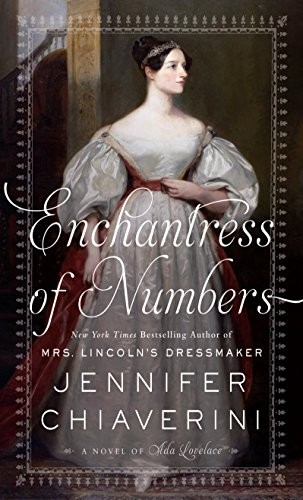M@ reviewed Enchantress of Numbers by Jennifer Chiaverini
Review of 'Enchantress of Numbers' on 'Goodreads'
This book's subtitle is a "novel of Ada Lovelace". Had I purchased in instead of borrowing it from the library, I would likely be suing the publisher for falsifying a subtitle (a felony in twenty-two states and Puerto Rico!). It would be better described as "a middling biography told for some inexplicable reason in the first person".
I made it well into the third chapter. At the time I gave up, Ada was thirteen months old, and relating the details of her mother's conversations with exquisite recall. A bit dry, but expecting a toddler to have a good grasp of what's interesting is unreasonable. And then the young Ada told me this.
My mother did not know then, and I would not discover for many years afterward, that it was in this same month that my father's illegitimate daughter was born in Bath, about one hundred twenty-five miles west …
This book's subtitle is a "novel of Ada Lovelace". Had I purchased in instead of borrowing it from the library, I would likely be suing the publisher for falsifying a subtitle (a felony in twenty-two states and Puerto Rico!). It would be better described as "a middling biography told for some inexplicable reason in the first person".
I made it well into the third chapter. At the time I gave up, Ada was thirteen months old, and relating the details of her mother's conversations with exquisite recall. A bit dry, but expecting a toddler to have a good grasp of what's interesting is unreasonable. And then the young Ada told me this.
My mother did not know then, and I would not discover for many years afterward, that it was in this same month that my father's illegitimate daughter was born in Bath, about one hundred twenty-five miles west of our lodgings in Hampstead. Called Allegra Byron, she was the daughter of Claire Clairmont, the stepsister of Mary Godwin Shelley. Mrs. Shelly, of course, was the wife of the poet Percy Blythe Shelley, the daughter of the writer Mary Wollstonecraft and the philosopher William Godwin, and the author of a remarkable novel, Frankenstein, which would be published the following year. I am unaware of any of Miss Clairmonts's accomplishments, and I never did meet her daughter, my half-sister, who died in Italy of an illness when she was only five years old. Throughout my childhood I had always longed for a sibling. Perhaps I somehow sensed that I had lost a sister and unwittingly grieved.
This was the last paragraph I read. What maniac editor let that beastly thing through? [a:Mary Wollstonecraft|1853305|Mary Wollstonecraft|https://images.gr-assets.com/authors/1228515449p2/1853305.jpg] wrote [b:A Vindication of the Rights of Women|39891524|A Vindication of the Rights of Women|Mary Wollstonecraft|https://images.gr-assets.com/books/1524108376s/39891524.jpg|61718247], which you'd think might warrant a mention in the laundry list of name-dropping. But one of the things that I've learned is that introducing her daughter as a wife first, as a daughter second, and as the inventor of Science Fiction third (and last) is...uh...kinda sexist.
If you want to read about the Hon. August Ada King-Noel, Countess of Lovelace, as you probably ought to, instead read [b:The Thrilling Adventures of Lovelace and Babbage|22822839|The Thrilling Adventures of Lovelace and Babbage|Sydney Padua|https://images.gr-assets.com/books/1412530488s/22822839.jpg|42375693]. While it is a graphic novel, the word "novel" is not a malapropism. It deals with a world where Ada doesn't die of uterine cancer at 36 and instead completes her work with Babbage on the difference and analytical engines, ushering in the information age and then fighting crime. But at the same time, it's dedicated to details! Primary source materials! It makes this fictional Ada Lovelace sound like the Lovelace of said primary source materials. You might even describe it as...novel.

